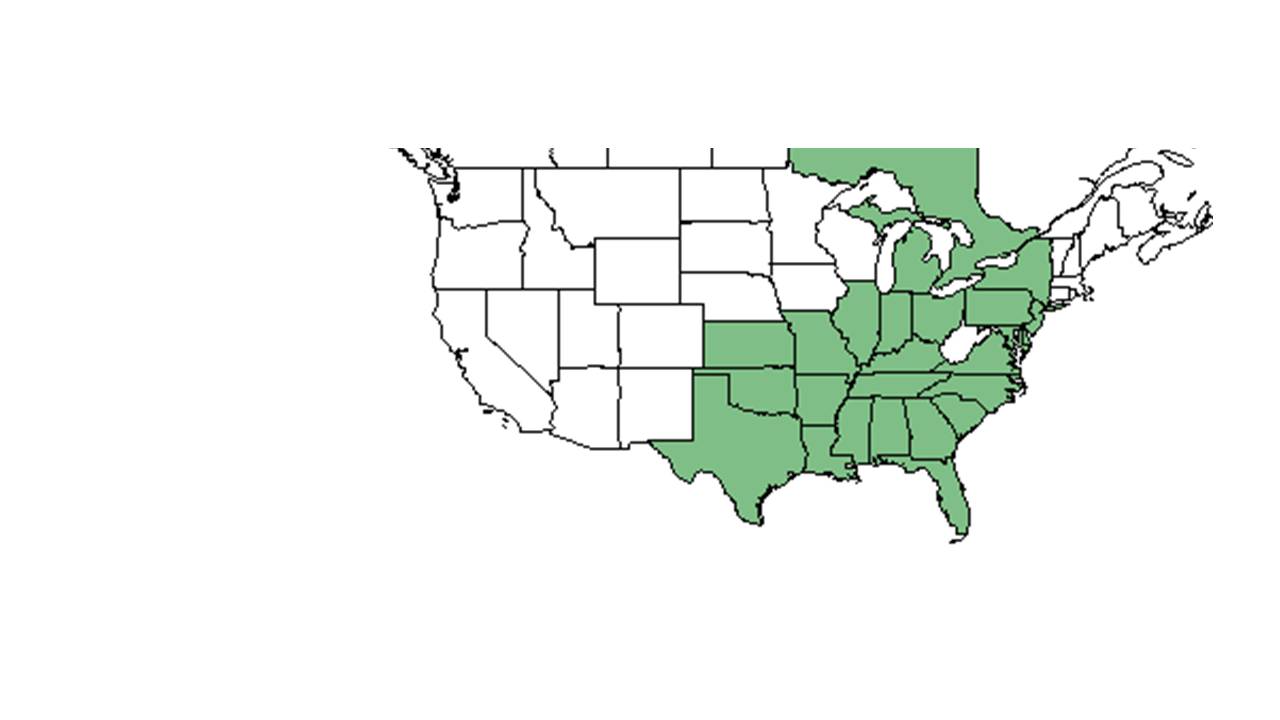Difference between revisions of "Buchnera americana"
KatieMccoy (talk | contribs) |
|||
| Line 26: | Line 26: | ||
===Habitat=== <!--Natural communities, human disturbed habitats, topography, hydrology, soils, light, fire regime requirements for removal of competition, etc.--> | ===Habitat=== <!--Natural communities, human disturbed habitats, topography, hydrology, soils, light, fire regime requirements for removal of competition, etc.--> | ||
''B. americana'' is found in moist environments near ponds and low brackish marshes, at the edges of hammocks, and in hillside bogs (FSU Herbarium). However, it can also appear in drier situations like savannas, pine flatwoods, dry open woods, hillside prairies, open prairies, coastal dunes, and shallow, grassy depressions (FSU Herbarium). In addition, it can be found in disturbed areas such as roadsides, ditches, sandy fields, open pasture, and clearings that have become weedy (FSU Herbarium). This species prefers open, sunny conditions, but occurs in a range of soil types, from dry loamy sand, to moist black sandy peat, seasonally damp areas, acidic sandy soils, and clay soils (FSU Herbarium). | ''B. americana'' is found in moist environments near ponds and low brackish marshes, at the edges of hammocks, and in hillside bogs (FSU Herbarium). However, it can also appear in drier situations like savannas, pine flatwoods, dry open woods, hillside prairies, open prairies, coastal dunes, and shallow, grassy depressions (FSU Herbarium). In addition, it can be found in disturbed areas such as roadsides, ditches, sandy fields, open pasture, and clearings that have become weedy (FSU Herbarium). This species prefers open, sunny conditions, but occurs in a range of soil types, from dry loamy sand, to moist black sandy peat, seasonally damp areas, acidic sandy soils, and clay soils (FSU Herbarium). | ||
| + | |||
| + | Associated species includes slash pine, longleaf pine, saw palmetto, cypress, ''Hypericum opacum, Eryngium integrifolium, Xyris elliottii, Habenaria integra, Polygala ramosa, Polygala lutea, Ctenium aromaticus, Hibiscus aculeatus, Lobelia, Baccharis, Myrica, Erigeron strigosus, Polypremum procumbens'', and others (FSU Herbarium). | ||
===Phenology=== <!--Timing off flowering, fruiting, seed dispersal, and environmental triggers. Cite PanFlora website if appropriate: http://www.gilnelson.com/PanFlora/ --> | ===Phenology=== <!--Timing off flowering, fruiting, seed dispersal, and environmental triggers. Cite PanFlora website if appropriate: http://www.gilnelson.com/PanFlora/ --> | ||
Revision as of 15:45, 20 October 2015
| Buchnera americana | |
|---|---|
Error creating thumbnail: Unable to save thumbnail to destination
| |
| photo by Gil Nelson | |
| Scientific classification | |
| Kingdom: | Plantae |
| Division: | Magnoliophyta - Flowering plants |
| Class: | Magnoliopsida - Dicotyledons |
| Order: | Scrophulariales |
| Family: | Scrophulariaceae |
| Genus: | Buchnera |
| Species: | B. americana |
| Binomial name | |
| Buchnera americana L. | |

| |
| Natural range of Buchnera americana from USDA NRCS Plants Database. | |
Common name: American bluehearts
Contents
Taxonomic notes
Description
Distribution
Ecology
Habitat
B. americana is found in moist environments near ponds and low brackish marshes, at the edges of hammocks, and in hillside bogs (FSU Herbarium). However, it can also appear in drier situations like savannas, pine flatwoods, dry open woods, hillside prairies, open prairies, coastal dunes, and shallow, grassy depressions (FSU Herbarium). In addition, it can be found in disturbed areas such as roadsides, ditches, sandy fields, open pasture, and clearings that have become weedy (FSU Herbarium). This species prefers open, sunny conditions, but occurs in a range of soil types, from dry loamy sand, to moist black sandy peat, seasonally damp areas, acidic sandy soils, and clay soils (FSU Herbarium).
Associated species includes slash pine, longleaf pine, saw palmetto, cypress, Hypericum opacum, Eryngium integrifolium, Xyris elliottii, Habenaria integra, Polygala ramosa, Polygala lutea, Ctenium aromaticus, Hibiscus aculeatus, Lobelia, Baccharis, Myrica, Erigeron strigosus, Polypremum procumbens, and others (FSU Herbarium).
Phenology
B. americana has been observed flowering as early as January, through October (FSU Herbarium). Fruiting has been observed February through November (FSU Herbarium).
Seed dispersal
Seed bank and germination
Fire ecology
Pollination
Use by animals
Diseases and parasites
Conservation and Management
Cultivation and restoration
Photo Gallery
References and notes
Florida State University Robert K. Godfrey Herbarium database. URL: http://herbarium.bio.fsu.edu. Last accessed: June 2014. Collectors: George R. Cooley, R. J. Eaton, O. Lakela, R. Kral, Elmer C. Prichard, Loran C. Anderson, Norlan C. Henderson, Mabel Kral, F. H. Sargent, Carroll E. Wood, Jr., Mary Atkinson, William P. Adams, C. Jackson, R.K. Godfrey, William Lindsey, W. P. Adams, Gary R. Knight, Jane Brockmann, Jackie Patman, James D. Ray, Gary R. Knight, Jean W. Wooten, Raymond Athey, Bruce Hansen, U. T. Waterfall, Paul L. Redfearn, Jr., Charles T. Bryson, A.F. Clewell, S.W. Leonard, Samuel B. Jones, Jr., John W. Thieret, Mary Margaret Williams, D. S. Correll, Chas. C. Deam, R. B. Channel, Josephine Skehan, Delzie Demaree, D.B. Ward, S.S. Ward, H.L. Blomquist, Baltzell, Kenneth A. Wilson, Grady W. Reinert, Julie Neel, R. A. Norris, R. Komarek, Thomas E. Miller, and James R. Burkhalter. States and Counties: Alabama: Wilcox. Arkansas: Prairie. Florida: Calhoun, Citrus, Charlotte, Collier, De Soto, Dixie, Escambia, Franklin, Hamilton, Hardee, Hernando, Highlands, Hillsborough, Jackson, Jasper, Lee, Leon, Levy, Liberty, Martin, Monroe, Osceola, Okaloosa, Pasco, Polk, Sarasota, St Johns, Taylor, Volusia, and Wakulla. Georgia: Charlton, Grady, McIntosh, and Thomas. Kentucky: Coffee and Lyon. Louisiana: Jefferson-Davis. Mississippi: Clay, Forrest, Jackson, and Newton. Missouri: Cambria, Cedar, Polk, and Vernon. North Carolina: Brunswick and Carteret. Oklahoma: Payne. South Carolina: Lee. Texas: Galveston.